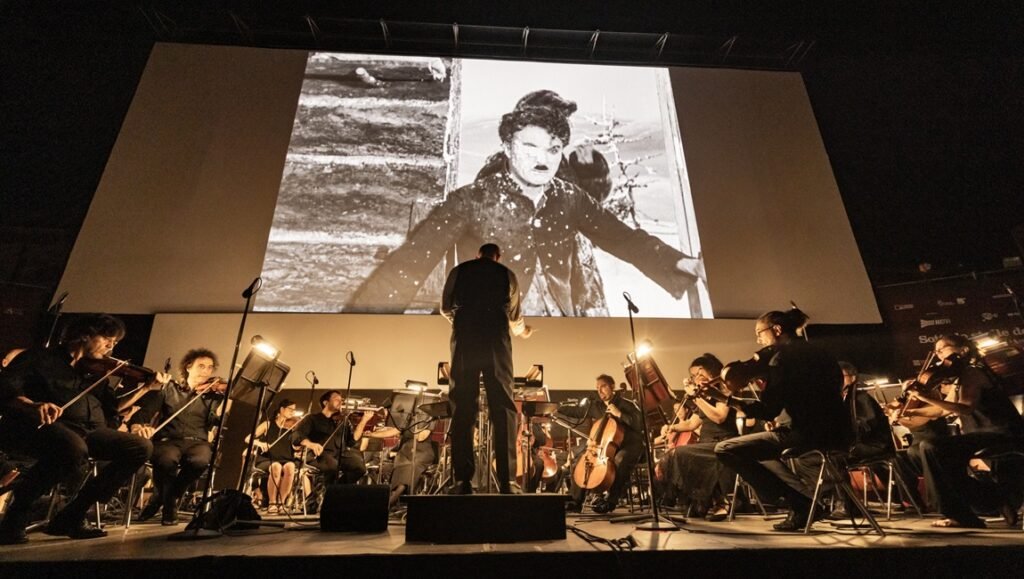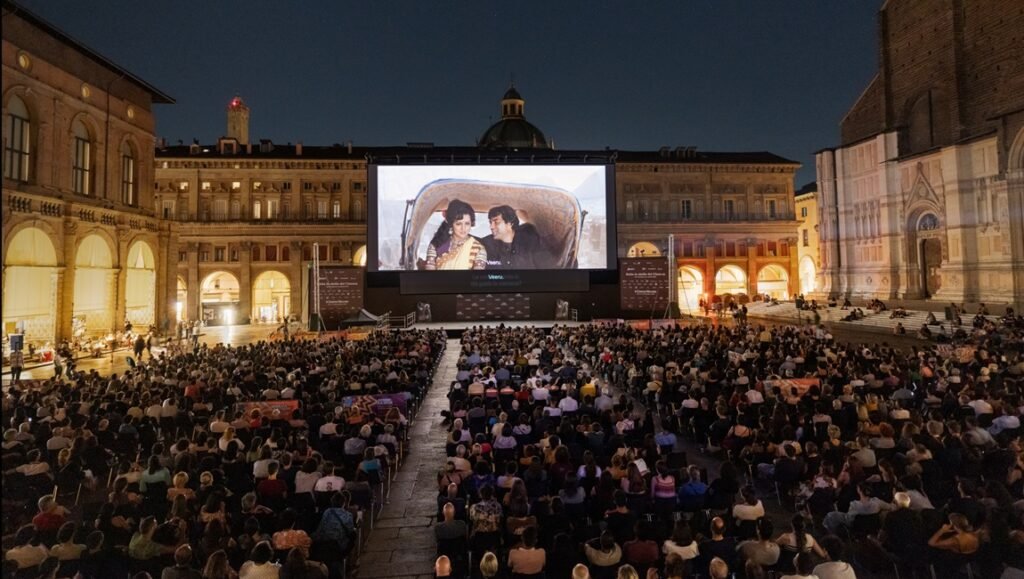Every summer, film obsessives make the pilgrimage to Bologna for Il Cinema Ritrovato — a week of restorations, rediscoveries, and archival oddities projected in cinemas and piazzas across the city. It’s probably the only place you’ll catch a 1905 dramatization of a mining disaster, then immediately queue for a 1981 documentary about the Los Angeles punk scene. The film I was most excited to see, though, was Strike — Sergei Eisenstein’s explosive 1925 portrait of collective revolt, screened under the stars in the Piazza Maggiore with a live score.
There was a certain irony, then, to my journey to Bologna being disrupted by a national rail strike. The plan — cheap flight to Pisa, quick regional train north — collapsed almost immediately. Trains were being cancelled at random. No one seemed to know which would run until it didn’t. Solidarity forever, but the journey was beginning to feel like a loyalty test issued by the ghost of Eisenstein. By Florence I was convinced I had fallen into some kind of cinephile purgatory, where my punishment for trying to save €40 on an airfare was to be slowly cooked alive on a platform while watching the train I needed pull away from me like Rossano Brazzi in Summertime (more on that later).
Rather than parading the newest, most brand-frothed films in front of an audience of caffeine-crazed critics and publicists, Il Cinema Ritrovato trades in revival. This is cinema as séance, or perhaps as salvage job. No red carpets, no Oscars buzz, no industry deals done in hotel bars. You don’t get bragging rights for being the first to see the recently recovered full-length cut of John Ford’s The Scarlet Drop (1918), at least not outside this small community of film nerds. But you will nevertheless find yourself running between screenings in the 38°C Bologna heat, half-mad from sunstroke and a hydration strategy based entirely on Campari.
The scale of the programme is overwhelming — not the algorithmic overwhelm of streaming platforms, but the panic of realizing you’re in a room full of treasures and your pockets are too small. There’s too much to report on everything I saw, never mind the films I missed. I managed to catch none of the pre-war Mikio Naruse or Lewis Milestone titles being showcased. What follows is a necessarily incomplete survey of personal highlights.

Every year, Il Cinema Ritrovato includes a strand of films from exactly 100 years ago. One of the most enjoyable programmes this year paired Walter Ruttmann’s Lichtspiel Opus II, III & IV with Viking Eggeling’s Symphonie Diagonale, originally shown together at Berlin’s legendary 1925 matinee Der absolute Film. Here they were shown on 35mm and accompanied by a gorgeous piano and live electronics accompaniment by Laura Naukkarinen and Matti Bye, which made these early abstract films feel closer to rave visuals than museum pieces. These were followed by a restoration of René Clair’s Le Voyage Imaginaire, in which a Paris bank clerk is whisked off to a subterranean fairyland. While not exactly a modernist masterpiece like the films that preceded it, it does feature some amusingly unexpected pop culture references: a “cat” is played by someone in a nightmarish Felix the Cat costume, and Charlie Chaplin (or a living waxwork of him, don’t ask) rescues our protagonist, now transformed into a dog (don’t ask), from the guillotine (!).
The strand surveying films from 20 years earlier, 1905, included shorts by pioneering filmmaker Alice Guy. Among them was La Esmeralda, her version of The Hunchback of Notre-Dame, long thought lost. I was even more taken with the documentary footage Guy shot while travelling through Spain — children pulling faces at the camera, a brief glimpse of Guy herself, the lone adult on the bridge, both bewildered and delighted by the youngsters’ enthusiasm. Another, Les Maçons (The Bricklayers), involved workmen acrobatically assaulting a pair of buffoonish policemen. No narrative pretext, just pure kinetic anti-authoritarianism, which felt right at home in a city tattooed with ACAB graffiti. I remembered a similar film from last year’s 1904 programme — was this a subgenre of early cinema? How far the medium has fallen, I thought, before recalling that viral clip of a Boston cop flying down a children’s slide at terminal velocity. Perhaps early cinema has been reborn as TikTok.
I wound up spending most of my time with the Katharine Hepburn retrospective, programmed by Molly Haskell. Besides discovering that Holiday (1938) is among the greatest of all time, the one that lingered longest was Stage Door (1937), in which Hepburn enters a run-down New York boarding house for actresses — Ginger Rogers among them. The film begins at screwball speed but ends with something nearer tragedy; nevertheless, it finds its soul in the flickers of solidarity that arise between the women. (The same could be said of Giuseppe De Santis’s Bitter Rice [1949], which has a new restoration and looks absolutely glorious — in Italy it’s treasured as a classic, but it deserves that accolade everywhere else.)
The later Hepburn vehicle Desk Set (1957) doesn’t have the same emotional sharpness, though Hepburn’s charm just about makes it work. What’s really surprising from a present-day vantage is that it’s about artificial intelligence. Hepburn and her co-workers run a reference library, where they learn their jobs will soon be replaced by a giant IBM-like computer. The film pivots from anti-AI satire to techno-capitalist fantasy in the final reel: the machine stays, so do the humans. I would love to see the missing scene where Spencer Tracy’s efficiency consultant convinces management to buy the world’s most expensive supercomputer and fire nobody.
More honest about the horrors of modernity was Corrado Farina’s They Have Changed Their Face (1971), in which a suited Dracula runs a car company and is named Giovanni Nosferatu. Slowly it becomes clear he runs everything else too. The film draws a razor-straight line from advertising to surveillance, from consumer fantasy to corporate fascism. It has all the gratuitous nudity you’d expect from a B-movie of the era, but also features parodies of Godard and Fellini, as well as a fleet of murderous Fiat 500s. I’m pretty sure it’s the only Dracula adaptation to end with a Marcuse quote.
Farina’s film screened in Cinema Europa, or “the sweatbox” — a nickname presumably earned as much for its reputation for showing disreputable films as for its feeble air conditioning. Case in point: a particularly sweaty screening of The Story of Joanna (1975), one of Deep Throat director Gerard Damiano’s efforts to merge porn with narrative cinema. If not quite as fun as his The Devil in Miss Jones, presented last year, Joanna’s treatment of sex is at least more experimental in form and content; a brief sex scene between the two male leads in an ostensibly straight porno still feels surprising. The acting is awful, but its kitsch approximation of Euro arthouse sophistication is, I must admit, a delight. At the festival again to introduce it were Damiano’s two adult children, which was both amusing and touching, sort of.

One genuine rediscovery this year was Robert Wilson and the CIVIL warS, a 1987 documentary that had all but vanished in the intervening decades. The second feature by Howard Brookner, best known for his film on William S. Burroughs, it follows avant-garde theatre legend Robert Wilson as he attempts to mount a global opera with Philip Glass for the 1984 Olympic Arts Festival in Los Angeles. The project is enormous, and eventually doomed by a snowballing budget. It reaches breaking point in Rome, where the Italian section is being rehearsed under a national electricians’ strike. A vast Abraham Lincoln puppet lurches backward on a poorly lit stage. Wilson, incandescent, storms out, refusing to continue unless the lights return. It’s tragic and, intentionally or not, very funny.
As always, the highlight was the nightly outdoor screenings in the Piazza Maggiore, which makes room for the public. These are typically introduced by Gian Luca Farinelli, director of the Cineteca di Bologna and something of a cult figure around the festival. (I overhear someone calling him “Jared Leto in House of Gucci, but a total sweetie.”) The original silent version of The Gold Rush (1925), newly restored and accompanied by a live orchestra, played to a packed and hugely receptive crowd. Sholay (1975), the delightfully maximalist Indian action epic, had some in the audience singing along. I have to salute whoever made the insane decision to unleash the Terrytoons short The Three Bears (1939) — a bonkers retelling of Goldilocks, and the origin of the “somebody toucha my spaghet!” meme — on hundreds of unsuspecting Italians there to see Five Easy Pieces (1970). Strike (1925) was as fierce and formally thrilling as I’d hoped — and it had the best live musical accompaniment of the festival.
On my last morning, there was time for one more film: David Lean’s Summertime (1955), another Hepburn, this time alone in Venice. The hyper-confidence of her earlier roles is stripped away — all that’s left is vulnerability. The film is often overshadowed in esteem by Lean’s own Brief Encounter, but it deserves better. It’s a sharp portrait of late love and the fear of change, shot on location with a painter’s eye. Hepburn’s abysmal Italian drew snickers from the audience, probably from both the international visitors and the Italians who have to put up with them for the duration of the festival. It ends with her leaving the city — and her lover — by train, the station platform receding behind her in a bittersweet long take. There were quiet sniffs across the cinema. “Oh well,” I thought. At least her train left on time.


Comments are closed.